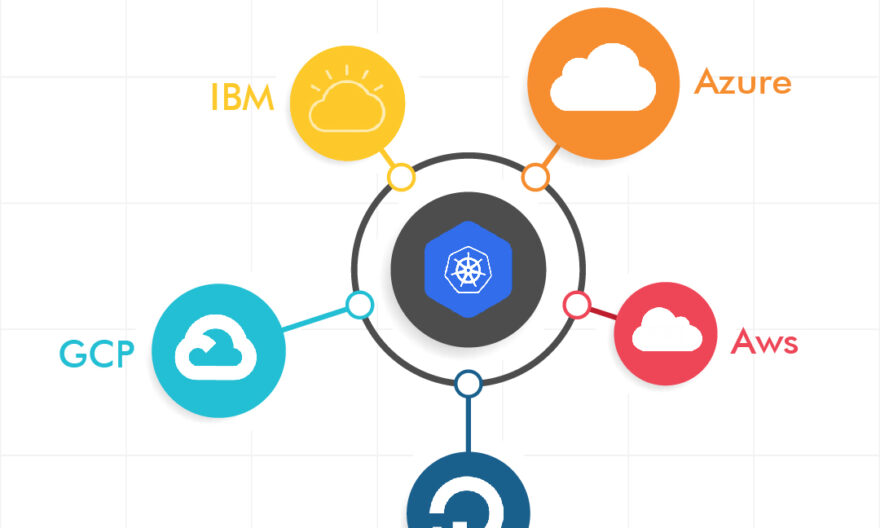
Kubernetes is a one-stop solution for all your application needs. It makes it easy to use applications and store data in the cloud. It works effectively as a container orchestration tool at Google. Moreover, Kubernetes has evolved to be the most versatile cloud-native technology.
But everything comes with flaws. And though Kubernetes stands as a flawless cloud technology, it comes with a few challenges. The challenges are mainly associated with deploying applications to a hybrid or multi-cloud environment using it.
Kubernetes has many advantages when it comes to deploying applications to multi-cloud. It helps distribute the workloads organizations have to deal with. It uses on-premise private and public cloud environments and other web-based public cloud environments to serve the purpose.
It works best with multiple platforms, such as Google Cloud Platform, Microsoft Azure, Amazon Web services, etc. But some issues always show up while deploying applications to multi-cloud environments. Here we have brought to you all the challenges Kubernetes faces with deployments.
Challenges of deploying applications to multi-cloud using Kubernetes
Ununified visibility
Visibility issues are most common while deploying applications to hybrid and multi-cloud using Kubernetes. It is because organizations work in teams. Hence, as the teams differ, they use it differently depending on their task and expertise.
It proves disadvantageous while deploying an application to multi-cloud. Centralized visibility usually lacks in such cases, which impacts cluster performance. If the organization faces problems related to cluster performance, it won’t be easy to fix.
Moreover, it raises the problem of operational insights. If the teams work differently with Kubernetes, obtaining insights on a common ground is a daunting task. This prevents the organization from delivering effective resource utilization.
Hence, we can decipher that though it solves the issue of observability and cost management, it still lies under the trap of ununified visibility. Unified visibility is a must for deploying applications in a multi-cloud environment.
Time-consuming
Time is the most important factor that organizations run on. Time efficiency is what they target while using hybrid and multi-cloud environments for deploying applications. It is why they approach open-source Kubernetes in the first place.
But it goes the other way around, as manual deployments are time-consuming. Using Kubernetes in production requires much effort from the side of the organization. The use of many open-source technologies while setting up, automating, and testing it eats up much time.
The infrastructure requirements for Kubernetes prove to be disadvantageous for organizations. Hence, time consumption is another challenge that hampers the effectiveness of Kubernetes while deploying applications to multi-cloud environments.
Uncontrolled access
There is also a need for access controls associated with the enterprise when we discuss deployments to a multi-cloud environment. Organizations must deal with intellectual property, regulated data, and many other situations.
It requires an effective division of labor to distribute the workforce between different organization clusters. However, enterprises need help accessing controls when handling applications using Kubernetes and deploying them to a multi-cloud environment.
They need help managing resource sharing and providing credentials to different clusters. There is a lack of effective policies that can handle accessibility issues. It adds to the operational costs and prevents organizations from meeting compliance requirements associated with internal and regulatory bodies.
The need for automation while using Kubernetes in a multi-cloud environment or different clusters in the same environment disturbs the workflow. Hence, it is another challenge organizations must face while using Kubernetes as a container orchestration tool in multi-cloud.
Overheads
Kubernetes also adds to the overheads of business organizations. Its operation can impact the business goals, thus making organizations prefer moving to cloud environments. But overheads increase as the business organizations use Kubernetes for application deployments to multi-cloud.
They face issues related to security, scale, and automation of resources in a new environment. It raises the operational burden and cost on business organizations. It also slows down the workflow speed and quality of services they offer.
Lack of external assistance
Kubernetes brings forth a need for more external assistance. It makes business operations complex. There are limited options for leveraging external support in cases of complicated operations. The operations require professional and experienced help. Hence, such limitations regarding external help pose a challenge to deploying applications over multi-cloud with Kubernetes.
Conclusion
Kubernetes stands as an effective container orchestration tool. It is the best way to transfer business resources to cloud environments. However, when it comes to deploying applications to hybrid and multi-cloud environments, Kubernetes faces a few challenges. It poses issues related to overhead costs, limited external support, lack of access controls, and visibility. Hence, Kubernetes has a huge scope for improvements and innovations to tackle these challenges associated with application deployments.
If you want to seek professional’s advice for cloud computing, contact itechops.

I love Kubernates